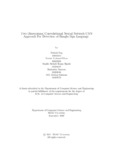| dc.contributor.advisor | Karim, Dewan Ziaul | |
| dc.contributor.advisor | Rahman, Rafeed | |
| dc.contributor.author | Nag, Pollock | |
| dc.contributor.author | Khan, Tamim Mahmud | |
| dc.contributor.author | Biplob, Shaikh Mehedi Hasan | |
| dc.contributor.author | Barmon, Rachayita | |
| dc.contributor.author | Rahman, MD. Minhaj | |
| dc.date.accessioned | 2023-10-16T08:42:02Z | |
| dc.date.available | 2023-10-16T08:42:02Z | |
| dc.date.copyright | ©2022 | |
| dc.date.issued | 2022-09-28 | |
| dc.identifier.other | ID: 18101114 | |
| dc.identifier.other | ID: 16101116 | |
| dc.identifier.other | ID: 18201087 | |
| dc.identifier.other | ID: 18201016 | |
| dc.identifier.other | ID: 18301072 | |
| dc.identifier.uri | http://hdl.handle.net/10361/21850 | |
| dc.description | This thesis is submitted in partial fulfillment of the requirements for the degree of Bachelor of Science in Computer Science and Engineering, 2022. | en_US |
| dc.description | Cataloged from PDF version of thesis. | |
| dc.description | Includes bibliographical references (page 39). | |
| dc.description.abstract | Sign language is known as the primary communication medium for deaf and mute
people. But the lack of available resources and a steep learning curve deter the
average person from learning it making communication with the mute and deaf
difficult. This problem creates an opportune place for the application of machine
learning which has given rise to our emerging field. A large number of papers with
high accuracy have already been published for English, French, and other languages.
But the number of papers on its application for Bangla Sign language is few. Most
of the researchers use SVM, ANN or KNN as classifiers. We chose CNN because it is
excellent at high accuracy image classification. In this paper we use a large dataset
consisting of 30 classes with 500 images each totalling to about 15000 images of
bangla sign alphabets. Previous works were done only on 10 classes. We began
work on those 10 bangla alphabets and later increased the number of classes to 30.
We tested the accuracy’s of pre trained CNN models such as DenseNet201,VGG16,
InceptionV3, Resnet50, MobileNetV2, InceptionResnet, EfficientnetB2 along with
our custom CNN model and were able to achieve 97.97%, 96%, 96.22%, 56.44%,
90%, 94%, 4%,98.3 % train accuracy and 86.43%, 88%, 88.33%, 54.50%, 60%, 53%,
4.2%,87% validation accuracy respectively. Our custom CNN model has consistently
given better training and validation accuracy than any pre-trained model with lesser
layers which in turn require less computations making for a lighter and faster model
while maintaining high accuracy. | en_US |
| dc.description.statementofresponsibility | Pollock Nag | |
| dc.description.statementofresponsibility | Tamim Mahmud Khan | |
| dc.description.statementofresponsibility | Shaikh Mehedi Hasan Biplob | |
| dc.description.statementofresponsibility | Rachayita Barmon | |
| dc.description.statementofresponsibility | MD. Minhaj Rahman | |
| dc.format.extent | 50 pages | |
| dc.language.iso | en | en_US |
| dc.publisher | Brac University | en_US |
| dc.rights | Brac University theses are protected by copyright. They may be viewed from this source for any purpose, but reproduction or distribution in any format is prohibited without written permission. | |
| dc.subject | KNN | en_US |
| dc.subject | CNN | en_US |
| dc.subject | Bangla sign language | en_US |
| dc.subject | InceptionV3 | en_US |
| dc.subject | VGG16 | en_US |
| dc.subject | Resnet50 | en_US |
| dc.subject.lcsh | Neural network (Computer sciences). | |
| dc.subject.lcsh | Human-computer interaction. | |
| dc.subject.lcsh | Sign language--Bengali language. | |
| dc.title | Two dimensional convolutional neural network CNN approach for detection of Bangla sign language | en_US |
| dc.type | Thesis | en_US |
| dc.contributor.department | Department of Computer Science and Engineering, Brac University | |
| dc.description.degree | B.Sc. in Computer Science and Engineering | |

